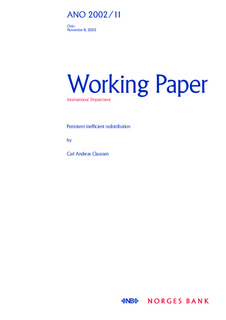| dc.contributor.author | Claussen, Carl Andreas | |
| dc.date.accessioned | 2018-05-22T08:50:17Z | |
| dc.date.available | 2018-05-22T08:50:17Z | |
| dc.date.issued | 2002 | |
| dc.identifier.isbn | 82-7553-202-7 | |
| dc.identifier.issn | 0801-2504 | |
| dc.identifier.uri | http://hdl.handle.net/11250/2498652 | |
| dc.description.abstract | Why do governments redistribute through indirect and inefficient means? An intuitive hypothesis is that it masks the real aim and cost of policy. In this paper we construct a dynamic model with an infinite horizon, political competition, rational individuals and asymmetric information regarding the efficiency of policy and politicians’ preferences to test this hypothesis. While the previous (formal) literature explains one-time projects like the building of a dam, bridge or an airport, we are able to explain the persistent use of inefficient means like regulation and subsidies for redistributive purposes. | nb_NO |
| dc.language.iso | eng | nb_NO |
| dc.publisher | Norges Bank | nb_NO |
| dc.relation.ispartofseries | Working Papers;11/2002 | |
| dc.rights | Attribution-NonCommercial-NoDerivatives 4.0 Internasjonal | * |
| dc.rights.uri | http://creativecommons.org/licenses/by-nc-nd/4.0/deed.no | * |
| dc.subject | JEL: D72 | nb_NO |
| dc.subject | JEL: C73 | nb_NO |
| dc.subject | political economy | nb_NO |
| dc.subject | inefficient redistribution | nb_NO |
| dc.subject | reform | nb_NO |
| dc.subject | special interests | nb_NO |
| dc.title | Persistent Inefficient Redistribution | nb_NO |
| dc.type | Working paper | nb_NO |
| dc.description.version | publishedVersion | nb_NO |
| dc.subject.nsi | VDP::Samfunnsvitenskap: 200::Økonomi: 210::Samfunnsøkonomi: 212 | nb_NO |
| dc.source.pagenumber | 16 | nb_NO |

